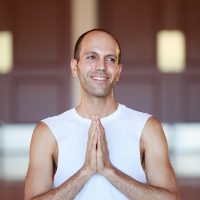When I had been teaching yoga and meditation for a few years, a couple of my closer students insisted that I follow through on an intention to teach an intensive teacher training retreat. I obliged, despite fearing that I would not know what to do, and that none other than they would actually attend.
The retreat turned out to be very challenging indeed, but also very rewarding; we went camping in Death Valley in March and I simply related what I had learned to a powerful group of students—one pose, one sutra, one breath at a time.
One training became two, three and four, and before I knew it, there was nothing else I wanted to do with my time.
Were it today, I would perhaps have known to start being worried; but at the time, devoting myself to teaching all day and every day seemed like salvation. I woke up before dawn to practice and meditate before my students awoke—in settings like Oregon’s Coquille River Valley and California’s Trinity Alps—and then taught asana, pranayama, meditation, and philosophy until long after the sun had set. When the group would have lunch, I would meet with individual students to listen, and to gently advise and direct. Hearts opened, tears flowed, and I started feeling like a genuine teacher.
The fairy tale did not begin to show cracks in the shell until I started noticing how disdainful I had grown of the long, empty days between teacher trainings. “Preference,” I thought to myself, “exactly that which I teach to be a fine foundation for suffering.” The empty quality of life outside teaching bore little resemblance to the luminous, cognizant emptiness by which the masters describe reality. The general sentiment was something like resentment, as though life were failing at its duty to challenge and fulfill me.
When the relationship in which I had been then failed, many of the shortcomings that I had hidden even from myself became public domain, and I experienced much disdain from former students. Some of these had even been on an honor system payment plan for training and chose to stop making payments. Self-loathing arose, accompanied with marvel at how quickly the proud fall, and what a satisfying thump they make when they hit the ground.
It was shortly thereafter that I learned what meditation might actually be, and began responding to the question “who is your teacher?” with “my therapist”.
It was in therapy that I first allowed another to be gently and compassionately “on my side”, as I had tried to be for my students. Self-loathing slowly began to turn into self-knowledge and a semblance of self-acceptance. Meditation became time to be with this one—this fragile, vulnerable being, right here. I realized that my failures were completely understandable, forgivable and human. Yet, trying to hide them from others in order to feel and appear accomplished made them unacceptable by virtue of sheer disappointment. My passion for teaching had itself been a form of sublimated self-loathing; an attempt to cease being this insignificant, suffering being—ugly in all the ways I did not want to be—and to disappear into the image of the true teacher. The old adage proved frustratingly true once more: wherever you go, there you are. The silver lining, however, did not fail to appear.
I still teach and train teachers with just as much enthusiasm, but perhaps with greater honesty. Experience, the greatest and perhaps the only teacher, seems to have conspired to teach its greatest (and perhaps its only) lesson: happiness lies not in becoming.
It is found in the willingness to simply be ourselves, all true teachings of No Self aside.
Simply ourselves. Beautiful in all the ways we did not want to be.











Read 8 comments and reply